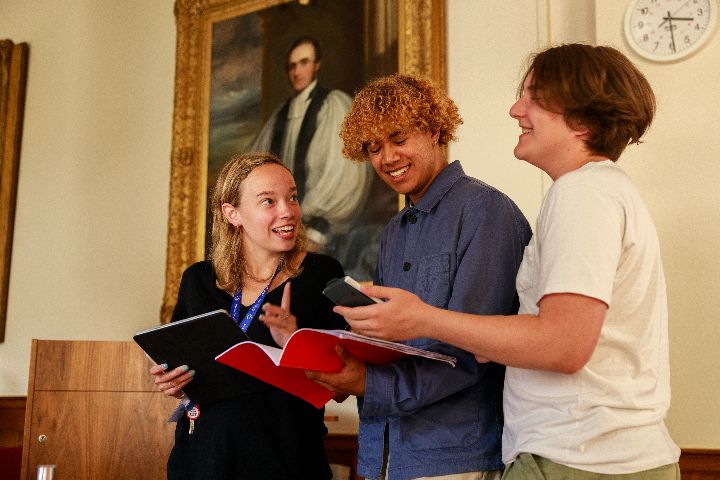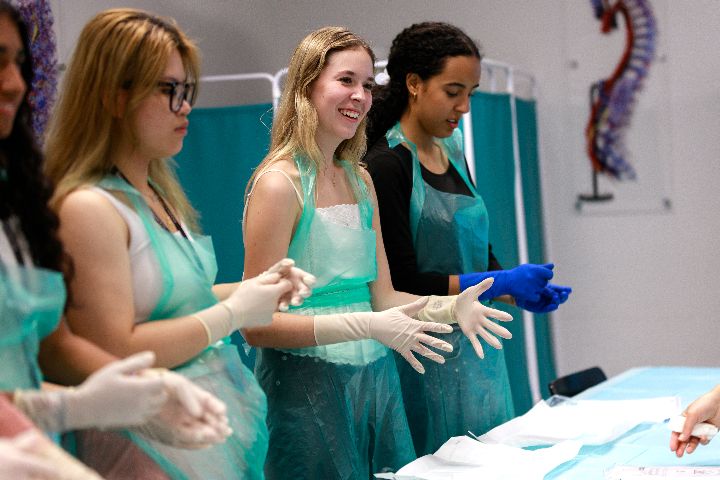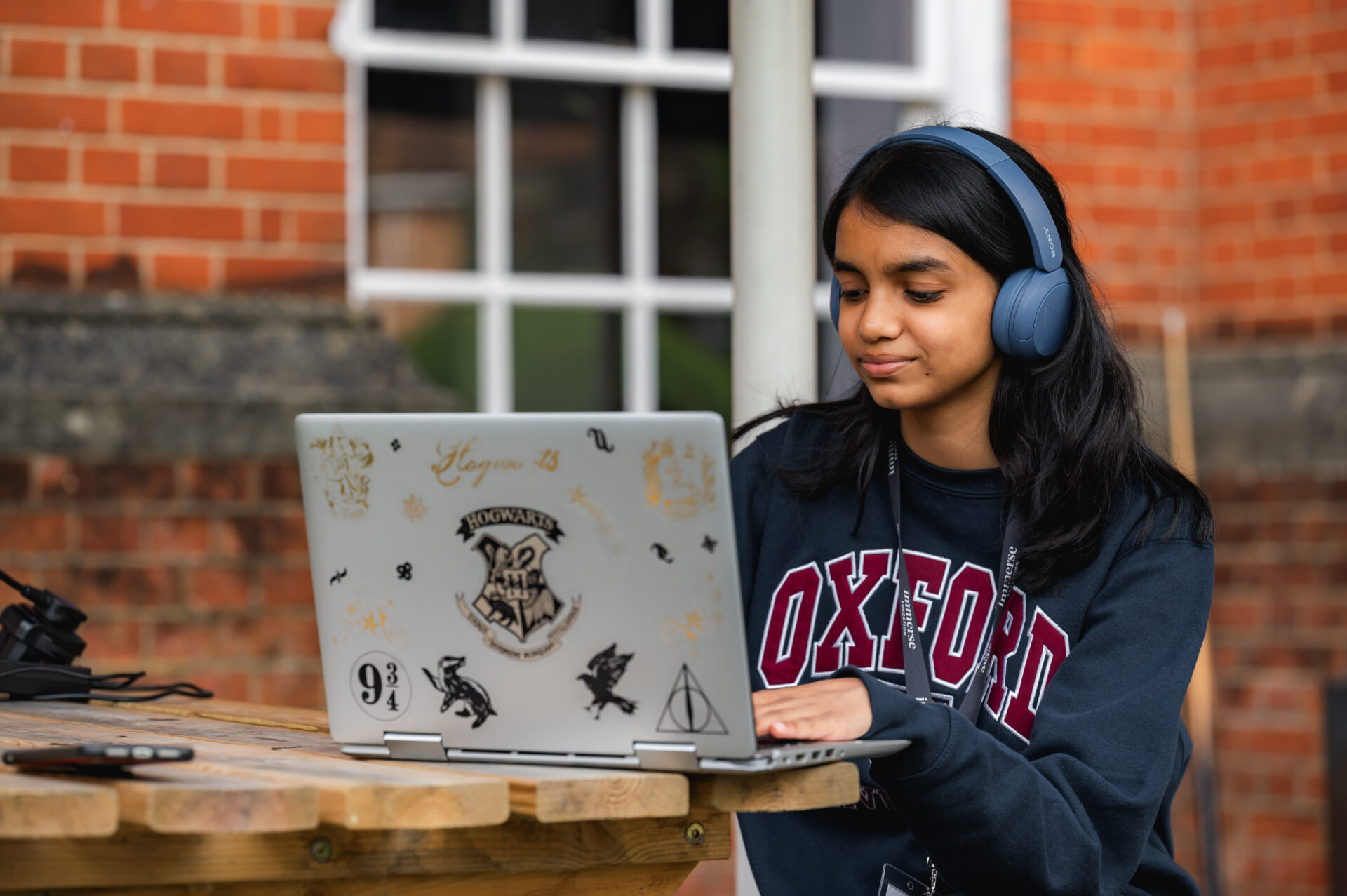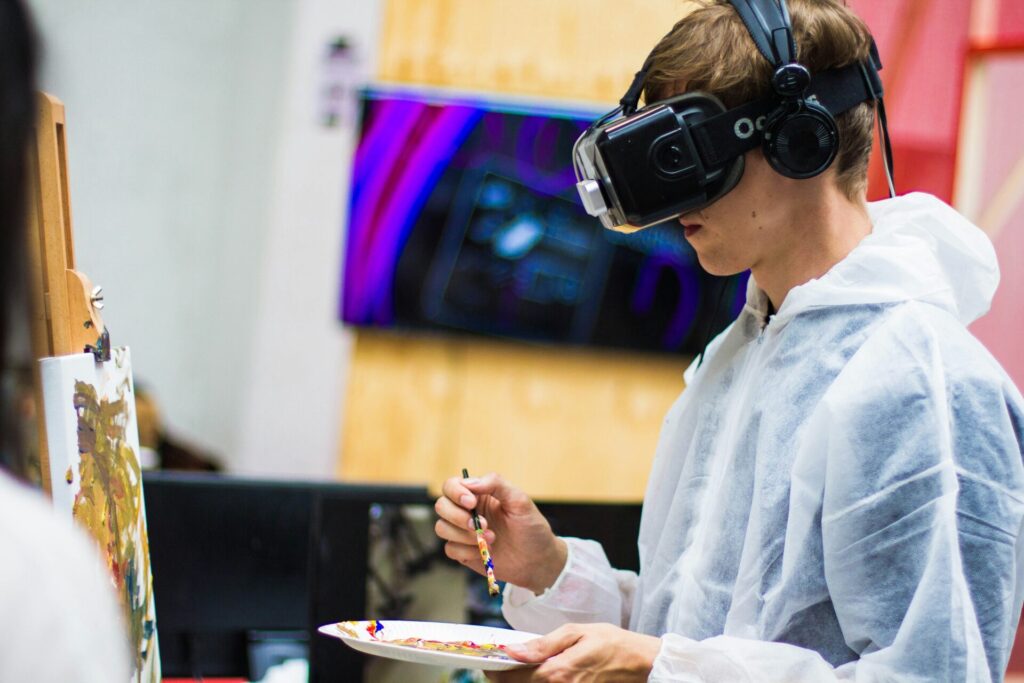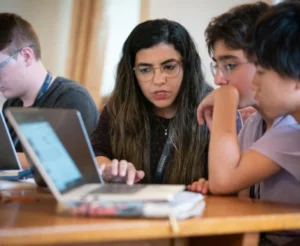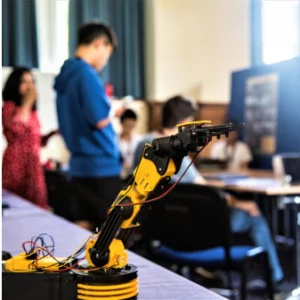Blended learning is reshaping education by combining traditional classroom instruction with digital tools and online resources. This flexible approach allows students to learn at their own pace while still engaging with teachers and peers in-person. As technology advances, blended learning is becoming increasingly popular across all levels of education, offering a dynamic and personalised learning experience.
We’ll explore further how it’s used in the classroom and what different models exist.
What Is Blended Learning?
Blended learning is an educational approach that integrates both traditional face-to-face instruction and online learning methods to create a more flexible and effective learning environment. This hybrid learning model allows students to engage with course materials through a mix of in-person lessons, digital resources, and interactive online content. The approach helps cater to different learning styles, ensuring that students can process information at their own pace while still benefiting from direct teacher interactions.
Blended learning has gained prominence due to advancements in educational technology. With the rise of e-learning platforms, schools and institutions worldwide have started integrating digital elements into their curricula. This shift allows educators to personalise instruction, provide instant feedback, and track student progress more efficiently. Furthermore, blended learning solutions are highly adaptable and can be customised for various subjects, making them suitable for primary, secondary, and higher education settings.
One of the key advantages of blended learning is its ability to bridge the gap between theoretical and practical knowledge. While students can learn foundational concepts through online modules, classroom interactions allow them to apply their understanding through discussions, group work, and hands-on activities. This dynamic approach creates a more engaging educational experience, fostering critical thinking and problem-solving skills.
Blended learning can take multiple forms depending on institutional needs and technological availability. Some institutions employ a flipped classroom model, where students review instructional content online before attending class. Others may use a flexible model, where students learn predominantly online but attend in-person sessions as needed. Regardless of the structure, the key objective of blended learning is to enhance student engagement and improve learning outcomes by leveraging the best aspects of both traditional and digital education.
Types of Blended Learning
Blended learning is a dynamic and multifaceted approach that integrates traditional classroom instruction with digital and online learning methods. It allows for greater flexibility, personalised instruction, and enhanced student engagement. Different models of blended learning cater to various educational needs, technological capabilities, and student preferences. Below, we explore five key models of blended learning, each with its own structure and benefits.
Flipped Learning Model
The flipped learning model reverses the traditional classroom approach by shifting direct instruction to an independent learning environment, allowing in-class time to be used for more interactive and practical activities. In this model, students engage with instructional materials—such as recorded lectures, readings, or multimedia presentations—outside of class. When they return to the classroom, they apply their knowledge through discussions, group work, and problem-solving exercises.
One of the primary advantages of the flipped model is that it empowers students to take control of their learning. Since they can pause, rewind, and review digital materials as needed, they can learn at their own pace. This is particularly beneficial for students who need additional time to grasp complex concepts or who prefer visual or auditory learning styles.
Teachers benefit from this model as well. By shifting lectures to a digital format, they can use classroom time more effectively, focusing on deepening students’ understanding through guided practice, collaboration, and critical thinking exercises. Research has shown that flipped learning can lead to higher student engagement and improved performance, particularly in subjects like mathematics and science, where problem-solving and active learning are crucial.
However, the flipped model does come with challenges. Not all students have equal access to technology or a quiet learning space at home. Additionally, it requires educators to redesign their curriculum to integrate digital content effectively, which can be time-consuming.
Face-to-Face Driver Model
The face-to-face driver model maintains the traditional classroom structure but supplements it with digital tools. In this model, online resources—such as interactive simulations, digital assessments, or online discussion boards—are used to reinforce learning, but in-person instruction remains the primary method of teaching.
This model is particularly effective for students who benefit from direct teacher supervision but also need additional support outside of class. It is widely used in K-12 education, where teachers might introduce digital platforms like Google Classroom or Khan Academy to provide additional practice and assessment.
One of the advantages of the face-to-face driver model is that it allows educators to differentiate instruction based on student needs. While the teacher delivers core instruction in person, students who need extra help can access supplementary materials online, and those who grasp concepts quickly can explore advanced resources at their own pace.
Despite its benefits, the model also has limitations. If the digital resources are not well-integrated, they can feel like an afterthought rather than a meaningful part of the learning experience. Additionally, the success of this model depends on the teacher’s ability to balance technology with traditional teaching without overwhelming students.
Rotation Model of Blended Learning
The rotation model divides learning into structured segments, where students rotate between different learning stations that include face-to-face instruction, online learning, collaborative group work, and hands-on activities. The most common variations of this model include station rotation, lab rotation, and individual rotation.
Station rotation is popular in elementary and middle school classrooms, where students move between different stations—such as teacher-led instruction, independent practice, and computer-based learning—during a single class period. This approach provides variety and engagement, ensuring that students interact with the material in multiple ways.
Lab rotation follows a similar structure but includes a designated computer lab where students complete their online learning component. This is particularly useful for schools with limited access to technology in the classroom.
Individual rotation allows students to follow a personalised learning path, moving between stations based on their specific needs and progress. This approach works well in self-paced learning environments and is commonly used in higher education and professional training programs.
The rotation model is beneficial because it keeps students actively engaged and caters to different learning styles. However, it requires careful lesson planning and classroom management to ensure smooth transitions between activities and that each station adds value to the learning process.
Flex Model Blended Learning
The flex model is a student-centered approach where online learning serves as the primary mode of instruction, with teachers providing support as needed. Unlike the rotation model, where online components supplement in-class instruction, in the flex model, students primarily learn through digital platforms while attending physical classrooms for additional guidance and assistance.
This model is particularly effective in higher education and adult learning environments, where learners may need more control over their schedules. Universities offering online degree programs often use the flex model, allowing students to complete coursework asynchronously while attending optional live discussions or office hours.
A significant advantage of the flex model is that it allows for self-paced learning, accommodating students with different learning speeds. It also enables teachers to focus on individualised support, offering targeted help rather than delivering the same instruction to the entire class.
However, the success of the flex model depends heavily on students’ ability to manage their own learning. Without strong self-discipline and motivation, some learners may struggle to keep up with coursework. Additionally, not all subjects are well-suited for fully online instruction, particularly those requiring hands-on practice, such as lab sciences and performing arts.
Enriched Virtual Model
The enriched virtual model is similar to the flex model but with a stronger emphasis on occasional in-person learning sessions. In this model, students complete most of their coursework online but attend scheduled face-to-face sessions for discussions, assessments, and interactive activities.
This model is often used in professional development programs and adult education, where learners may have work or family commitments that prevent them from attending daily classes. Many online MBA programs and executive education courses follow this format, offering periodic in-person seminars or networking events.

One of the biggest advantages of the enriched virtual model is that it allows greater flexibility for students while maintaining some level of face-to-face interaction. It also provides opportunities for peer collaboration and experiential learning that might be missing in fully online programs.
However, since much of the learning occurs remotely, students in this model must be highly self-motivated. Additionally, institutions need to ensure that the in-person components are meaningful and engaging, rather than just fulfilling a requirement for face-to-face meetings.
Benefits of Blended Learning
Blended learning offers numerous benefits for both students and educators. Some of the most significant advantages include:
- Flexibility: Students can access materials anytime, anywhere, making learning more convenient and adaptable.
- Personalisation: Adaptive technologies allow instructors to tailor lessons to individual student needs.
- Enhanced Engagement: Interactive multimedia content, such as videos, quizzes, and simulations, makes learning more dynamic.
- Efficient Use of Classroom Time: By shifting some instructional elements online, teachers can use class time for more interactive activities.
- Cost-Effectiveness: Digital resources reduce the need for printed materials, making education more sustainable.
- Improved Performance Tracking: Learning management systems (LMS) provide real-time insights into student progress, enabling targeted interventions.
- Accessibility: Students from different geographical locations or with different learning needs can access high-quality education.
- Encouragement of Independent Learning: With access to digital resources, students learn to take responsibility for their own learning process.
- Collaboration Opportunities: Online forums and discussion boards foster communication and teamwork among students, even when learning remotely.
- Increased Retention Rates: Studies show that students engaged in blended learning tend to retain more information due to diversified instructional methods.
- Scalability for Institutions: Schools and universities can expand their reach by offering blended programs that accommodate more students without overwhelming physical infrastructure.
- Incorporation of Real-World Skills: Many blended learning models emphasise project-based learning, critical thinking, and digital literacy—essential skills for today’s workforce.
Blended Learning Examples
Blended learning is widely applied across various educational levels and industries. Some notable examples include:
- Higher Education: Universities offer hybrid courses, where students alternate between online lectures and in-person labs. This format is particularly effective in disciplines like engineering, medicine, and business, where theoretical knowledge must be paired with hands-on practice.
- Corporate Training: Companies use a mix of e-learning platforms and workshops to upskill employees. For example, businesses in the tech sector often provide online coding courses supplemented with live coding sessions and mentorship.
- K-12 Schools: Many schools supplement traditional learning with educational apps and virtual classrooms. Programs like Google Classroom and Microsoft Teams allow teachers to assign work online, track progress, and provide immediate feedback.
- Healthcare Training: Medical students engage in virtual simulations before handling real-world cases. Virtual reality (VR) is increasingly being used to simulate surgeries and patient interactions, ensuring that learners acquire practical experience in a controlled setting.
- Language Learning: Online language platforms integrate video lessons with live tutoring sessions. Duolingo, Babbel, and Rosetta Stone use artificial intelligence to personalise lessons, while students can participate in virtual language exchange programs with native speakers.
- Professional Development: Organisations incorporate blended learning in leadership training and career development programs. For instance, companies like LinkedIn Learning offer online courses combined with in-person networking events and industry-specific workshops.
- Military and Defense Training: The military has long used blended learning to train personnel. Simulations, digital training modules, and live drills ensure soldiers acquire both theoretical knowledge and practical field experience.
- STEM Education: Science, Technology, Engineering, and Mathematics (STEM) fields heavily rely on blended learning. Online simulations and lab-based experiences work together to help students grasp complex concepts in fields like robotics and biotechnology.
Join the Immerse Education 2024 Essay Competition
The Immerse Essay Competition is open for 2024! Follow the instructions to write and submit your best essay for a chance to be awarded a 100% scholarship.

How to Create a Blended Learning Lesson
Creating a blended learning program requires careful planning to ensure a seamless integration of online and face-to-face instruction. Educators must design lessons that leverage digital tools while maintaining the benefits of in-person engagement. A well-structured blended lesson enhances student learning, increases flexibility, and provides opportunities for individualised instruction. Below, we outline the essential steps to create an effective blended learning strategy that balances traditional and digital learning components.
1. Define Learning Objectives
The first step in designing a blended learning program is to establish clear learning objectives. These objectives should align with curriculum standards and define what students should know or be able to do by the end of the lesson. Educators should determine which concepts are best taught through direct instruction and which can be reinforced through digital resources.
For example, complex theoretical concepts might be introduced through pre-recorded video lectures, while hands-on applications and discussions can take place in the classroom. Blended instruction works best when online and offline elements complement each other rather than operate as separate entities.
2. Select Digital Tools and Resources
The next step is to choose the right technology to support the lesson. Educators can use a variety of tools, including:
- Learning Management Systems (LMS) like Moodle, Canvas, or Google Classroom to organise content and track student progress.
- Video-based learning tools like Edpuzzle or Khan Academy for pre-recorded lectures and interactive learning experiences.
- Online assessments and quizzes using platforms like Kahoot! or Quizizz to gauge student understanding.
- Collaborative tools such as discussion forums, Padlet, or Google Docs to facilitate group work and peer interaction.
Selecting the right tools ensures that students remain engaged while benefiting from self-paced learning opportunities.
3. Design Engaging Online and Offline Activities
A blended learning strategy should incorporate engaging and interactive activities that encourage participation. Educators should consider a mix of synchronous and asynchronous learning experiences.
- Asynchronous components: Students complete pre-recorded lectures, reading assignments, or interactive modules at their own pace.
- Synchronous components: In-person or live virtual sessions are used for discussions, Q&A sessions, collaborative projects, and hands-on learning.
Educators should ensure that students have opportunities to apply what they have learned online in a meaningful way during face-to-face sessions.
4. Implement Blended Instruction and Facilitate Learning
Blended instruction requires teachers to play a facilitator role rather than just delivering content. During face-to-face sessions, educators should focus on active learning techniques, such as problem-solving exercises, peer discussions, and case studies. The teacher should monitor student progress through both in-person interactions and digital analytics available through the LMS.
Providing timely feedback is crucial. Educators should use a combination of automated assessments (quizzes, discussion posts) and direct teacher evaluations to ensure that students stay on track. Data from online learning platforms can help teachers identify struggling students and provide personalised support.
5. Assess and Improve the Lesson
The final step in building a successful blended learning program is evaluating its effectiveness. Educators should collect student feedback, analyse engagement metrics from digital platforms, and assess learning outcomes to make necessary adjustments.
A blended learning strategy should remain flexible, allowing for continuous improvement. Teachers should refine lesson structures based on student performance and feedback, ensuring that the blended model enhances learning rather than complicating it.
By following these steps, educators can design blended instruction that maximises the benefits of both digital and in-person learning, creating an engaging and effective educational experience.
LMS and Blended Learning
A learning management system (LMS) plays a crucial role in blended learning by providing a centralised platform for course materials, assignments, and assessments. Some of the best LMS platforms for blended learning include:
- Moodle: An open-source LMS used by schools and universities worldwide. Moodle allows for extensive customisation, enabling educators to design courses tailored to their instructional needs.
- Canvas: A widely adopted platform known for its intuitive interface and comprehensive analytics. Institutions use Canvas to integrate multimedia content, track student engagement, and streamline grading.
- Blackboard: Popular among higher education institutions for managing coursework and assessments. Blackboard’s tools include discussion boards, live collaboration features, and AI-driven insights into student performance.
- Google Classroom: Frequently used in K-12 education due to its integration with Google tools. Teachers can create, distribute, and grade assignments within the same ecosystem, making it highly efficient.
LMS platforms allow educators to organise materials, track student performance, and streamline communication, making them essential for implementing blended learning effectively. Many LMS platforms also offer data analytics, allowing educators to monitor student engagement and adjust teaching strategies accordingly.
Beyond formal education, LMS platforms are widely used in corporate settings, helping companies deliver employee training programs. Platforms like TalentLMS and SAP Litmos allow businesses to create customised learning paths for employees, ensuring they gain industry-specific skills.
LMS systems also facilitate peer-to-peer learning, allowing students to collaborate on projects, participate in discussion forums, and provide feedback to one another. With the integration of artificial intelligence, LMS platforms are becoming increasingly adaptive, providing personalised learning experiences tailored to each student’s strengths and weaknesses.
Conclusion
Blended learning continues to transform education by integrating traditional and digital methodologies. As institutions adapt to technological advancements, blended learning will remain a key strategy for enhancing student engagement and improving learning outcomes. The flexibility, accessibility, and efficiency of blended learning make it an invaluable tool for educators and students alike.
As educational technology evolves, future trends such as artificial intelligence, virtual reality, and gamification will further refine and enhance blended learning models. Institutions that embrace these advancements will be better equipped to meet the diverse needs of learners in an increasingly digital world.
Blended learning not only improves academic outcomes but also equips students with the skills needed for the modern workforce. By fostering independent learning, collaboration, and digital literacy, blended education prepares learners for success in both academic and professional settings.
Explore our summer programmes to see how both virtual and in-person learning can enhance students’ outcomes.
